Enhanced TDS
Identification & Functionality
- Chemical Family
- RTU Product Type
- Technologies
- Product Families
Features & Benefits
- Ready-to-Use Product Features
- Features and Benefits
- Very high mechanical and electrical properties at elevated temperature.
- High thermal shock resistance.
- High toughness combined with elevated glass transition temperature.
Applications & Uses
- Application Area
- Composites Processing Methods
- Cure Method
- Product End Uses
- Markets
- Applications
- Application Information
- Indoor electrical insulators for medium and high voltage, such as switch and apparatus components.
- Encapsulation of large metal parts.
- Recommended for applications with long term stresses up to service temperature of approx. 90°C.
- Processing Information
The effective pot-life of the mix is about 2 days at temperatures below 25°C. Conventional batch mixers should be cleaned once a week or at the end of work. For longer interruptions of work, the pipes of the mixing and metering installations have to be cooled and cleaned with the resin component to prevent sedimentation and/or undesired viscosity increase. Interruptions over a week-end (approx. 48h) without cleaning are possible if the pipes are cooled at temperatures below 18°C. For the APG process, an increase of the filler content, e.g. 300 pbw. is recommended. Viscosity increase and gel time at various temperatures, refer to Figs: 4.1 and 4.4.
Mold temperature
APG process 130 - 160°C
Conventional vacuum casting 70 - 100°C
Demolding times (depending on mold temperature and casting volume)
APG process 12 - 40 min
Conventional vacuum casting 5 - 8h
Cure conditions (minimal postcure)
APG process 4h at 130°C or 3h at 140°C
Conventional vacuum casting 12h at 130°C or 10h at 140°C
To determine whether crosslinking has been carried to completion and the final properties are optimal, it is necessary to carry out relevant measurements on the actual object or to measure the glass transition temperature. Different geling and cure cycles in the manu-facturing process could lead to a different crosslinking and glass transition temperature respectively.Processing Viscosities

Fig.4.1: Viscosity increase at 40, 60 and 80°C (measurements with Rheomat 115) (Shear rate D = 10 s-1)
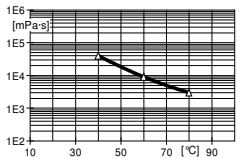
Fig.4.2: Initial viscosity as a function of temperature (measurements with Rheomat 115, D = 10 s⁻¹)
Gelation and Cure Times
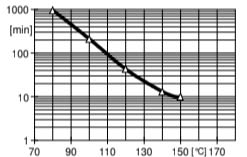
Fig.4.4: Geltime as a function of temperature (measured with the Gelnorm instrument, DIN 16945/6.3.1)
Mechanical and Physical Properties
Key Value Unit Test Method Condition Tensile strength 80 - 90 MPa ISO 527 Cured for 2h at 100°C + 10h at 140°C
Elongation at break 1.3 - 1.5 % ISO 527 Cured for 2h at 100°C + 10h at 140°C
E modulus from tensile test 8,600 - 9,600 MPa ISO 527 Cured for 2h at 100°C + 10h at 140°C
Flexural strength 125 - 135 MPa ISO 178 Cured for 2h at 100°C + 10h at 140°C
Surface strain 1.8 - 2.0 % ISO 178 Cured for 2h at 100°C + 10h at 140°C
E modulus from flexural test 9,100 - 9,500 MPa ISO 178 Cured for 2h at 100°C + 10h at 140°C
Impact strength 11 - 13 kJ/m² ISO 179 Cured for 2h at 100°C + 10h at 140°C
Critical stress intensity factor (KIC) 2.4 - 2.6 MPa·m¹/² CG 216-0/89 Cured for 2h at 100°C + 10h at 140°C
Specific energy at break (GIC) 575 - 625 J/m² CG 216-0/89 Cured for 2h at 100°C + 10h at 140°C
Glass transition temperature (DSC) 115 - 125 °C IEC 1006 Cured for 2h at 100°C + 10h at 140°C
Coefficient of linear thermal expansion (20-80°C) 35 - 39 x10⁻⁶ K⁻¹ DIN 53752 Cured for 2h at 100°C + 10h at 140°C
Thermal conductivity 0.75 - 0.8 W/m·K Similar to ISO 8894-1 Cured for 2h at 100°C + 10h at 140°C
Flammability (Thickness of specimen: 4 mm) HB UL 94 Cured for 2h at 100°C + 10h at 140°C
Flammability (Thickness of specimen: 12 mm) HB UL 94 Cured for 2h at 100°C + 10h at 140°C
Water absorption (10 days at 23°C) c. 0.15 % by wt ISO 62 Cured for 2h at 100°C + 10h at 140°C
Water absorption (100 hours at 100°C) 0.65 - 0.70 % by wt ISO 62 Cured for 2h at 100°C + 10h at 140°C
Decomposition temperature (TGA) c. 350 °C DTA Cured for 2h at 100°C + 10h at 140°C
Density (Filler load: 60% by weight) 1.70 - 1.80 g/cm³ DIN 55990 Cured for 2h at 100°C + 10h at 140°C
Electrical Properties
Key Value Unit Test Method Condition Breakdown strength (IEC 60243-1) 19 - 23 kV/mm IEC 60243-1 Cured for 2h at 100°C + 10h at 140°C
Diffusion breakdown strength (DIN/VDE 0441/1) HD 2 Class DIN/VDE 0441/1 Cured for 2h at 100°C + 10h at 140°C
Temperature of specimen after test < 23 °C N/A Cured for 2h at 100°C + 10h at 140°C
HV arc resistance (ASTM D 495) 182 - 185 sec ASTM D 495 Cured for 2h at 100°C + 10h at 140°C
Tracking resistance (IEC 60112) CTI > 600 - 0.0 IEC 60112 Cured for 2h at 100°C + 10h at 140°C
Tracking resistance (with test solution B) CTI > 600M - 0.0
IEC 60112 Cured for 2h at 100°C + 10h at 140°C
Electrolytic corrosion (DIN 53489) A-1 Grade DIN 53489 Cured for 2h at 100°C + 10h at 140°C
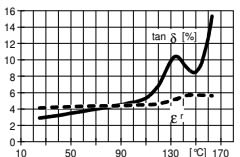
Fig.6.1: Loss factor (tan δ) and dielectric constant (εr) as a function of temperature (measurement frequency: 50 Hz, IEC 60250/ DIN 53483)
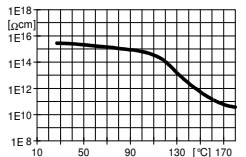
Fig.6.2: Volume resistivity (ρ) as a f (T) (measurement voltage: 1000 V, IEC 60093/ DIN 53482)
Mechanical Values
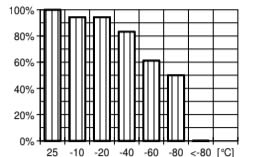
Fig.7.1: Crack resistance / Temperature shock test Passed specimen (%) as a function of temperature steps Mean failure temperature: -77°C Embedded metal parts with 2 mm radius
Properties
- Physical Form
Technical Details & Test Data
- System Preparation
General instructions for preparing liquid resin systems.
Long pot life is desirable in the processing of any casting resin system. Mix all of the components together very thoroughly at room temperature or slightly above and under vacuum. Intensive wetting of the filler is extremely important. Proper mixing will result in:
- Better flow properties and reduced tendency to shrinkage
- Lower internal stresses and therefore improved mechanical properties on object
- Improved partial discharge behaviour in high voltage applications.
For the mixing of medium to high viscous casting resin systems and for mixing at lower temperatures, we recommend special thin film degassing mixers that may produce additional self-heating of 10-15°C as a result of friction. For low viscous casting resin systems, conventional anchor mixers are usually sufficient.
In larger plants, two pre-mixers are used to mix the individual components with the respective quantities of fillers and additives under vacuum. Metering pumps then feed these premixes to the final mixer or a continuous mixer. The individual premixes can be stored at elevated temperature (about 60°C) for up to about 1 week, de-pending on formulation. Intermittent agitation during storage is advisable to prevent filler sedimentation.
Mixing time can vary from 0.5 to 3 hours, depending on mixing temperature, quantity, mixing equipment and the particular application. The required vacuum is 0.5 to 8 mbar. Degassing time is recommended at least 1 hour. The vapour pressure of the individual components should be taken into account.
In the case of dielectrically highly stressed parts, we recommend checking the quality consistency and pre-drying of the filler. Their moisture content should be max. 0.2%.
Storage & Handling
- Storage Conditions
Store the components in a dry place according to the storage conditions stated on the label in tightly sealed original containers. Under these conditions, the shelf life will correspond to the expiry date stated on the label. After this date, the product may be processed only after reanalysis. Partly emptied containers should be tightly closed immediately after use. For information on waste disposal and hazardous products of decomposition in the event of a fire,
Other
- Application Information
Value Units Test Method / Conditions Mix Ratio 2.7 %(W) %(W) Filler : Resin Mix Ratio 0.8 %(W) %(W) Hardener : Resin - Physical Properties
Value Units Test Method / Conditions Glass Transition Temperature (Tg) 120.0 °C °C
